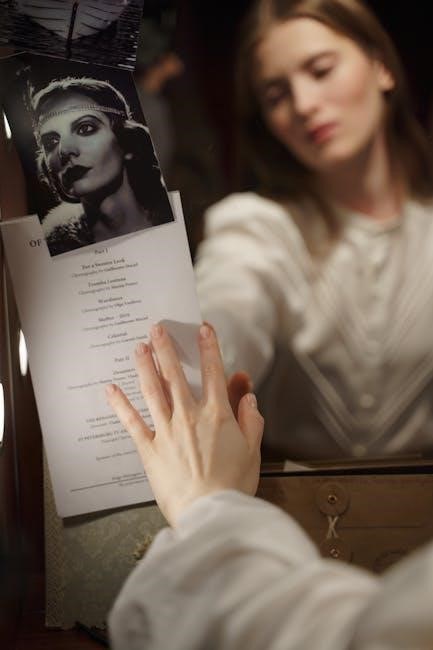The Crucible Act 3 reading guide provides context for the trials, using
- ordered lists
to outline key events and
character motivations
in a clear and concise manner always.

Setting of Act 3
The setting of Act 3 in The Crucible is primarily the vestry room of the Salem church, which has been converted into a courtroom. This setting is significant as it highlights the blending of church and state, with the church taking on a judicial role. The use of the church as a courtroom also adds to the sense of intimidation and fear that pervades the community. The courtroom setting allows for a sense of formality and legitimacy to be bestowed upon the trials, which in turn lends credibility to the accusations of witchcraft. The setting also serves to heighten the tension and drama of the scene, as the characters navigate the complex web of accusations and defenses. The vestry room setting is also symbolic of the community’s values and beliefs, with the church representing a moral authority. The courtroom setting is used to explore the themes of the play, including the dangers of unchecked power and the importance of truth and justice. The setting of Act 3 is crucial in understanding the plot and characters of The Crucible, and provides a unique perspective on the events that unfold. The use of this setting allows the author to comment on the societal norms of the time.

Plot Summary of Act 3
Act 3 unfolds with intense
- interrogations
and dramatic
revelations
that escalate the conflict always.
Key Events in Act 3
The key events in Act 3 of The Crucible are crucial to the plot’s progression, with the court proceedings taking center stage. The scene opens with Judge Hawthorne interrogating Martha Corey, and Giles Corey and Francis Nurse demanding to share their evidence. The atmosphere is tense, with the characters’ emotions running high. The use of
- ordered lists
can help to outline these events, making it easier to follow the narrative. As the act unfolds, the audience is presented with a series of dramatic revelations, including Mary Warren’s desire to confess that the girls’ testimony is false. The character of John Proctor is also significant, as his confession of his affair with Abigail Williams has a profound impact on the story. The events in Act 3 are expertly woven together, creating a sense of urgency and suspense that propels the plot forward. The
character interactions
and
plot twists
are essential to understanding the themes and motifs that emerge in this act. By examining these key events, readers can gain a deeper understanding of the play’s complexities and nuances. The act’s events are a pivotal part of the narrative, driving the story towards its culmination.

Character Analysis in Act 3
Characters’ motivations and emotional states are expertly revealed through dialogue and actions always clearly.
Abigail’s Role in Act 3
Abigail’s character plays a significant role in Act 3, as her accusations and testimonies continue to influence the trials. Through her interactions with other characters, particularly John Proctor, Abigail’s motivations and emotions are revealed, showcasing her complexity as a character. The use of dialogue and stage directions allows the reader to understand Abigail’s actions and their consequences. As the act progresses, Abigail’s role in the trials becomes more pronounced, highlighting the themes of deception and manipulation. Her character serves as a catalyst for the events that unfold, demonstrating the destructive power of false accusations and the dangers of unchecked emotions. The portrayal of Abigail in Act 3 is a crucial aspect of the play, as it sheds light on the psychological and emotional factors that drive her actions, making her a fascinating and multifaceted character to analyze. Furthermore, Abigail’s interactions with other characters, such as Danforth and Hathorne, reveal the inner workings of the court and the motivations of those involved in the trials. Overall, Abigail’s role in Act 3 is a pivotal element of the play, driving the plot forward and exploring the complexities of human nature.
Proctor’s Confession in Act 3
John Proctor’s confession in Act 3 is a pivotal moment in the play, as he finally admits to his affair with Abigail. This confession is a result of the intense pressure and interrogation by Judge Danforth, who is determined to uncover the truth. Through the use of imagery and symbolism, Miller highlights the emotional turmoil that Proctor experiences as he struggles to come to terms with his past mistakes. The confession also serves to reveal the complexities of Proctor’s character, showcasing his flaws and weaknesses, as well as his integrity and honesty. As Proctor’s confession unfolds, it becomes clear that his actions were motivated by a desire to protect his wife and reputation, rather than a desire to deceive or manipulate others. The character development that occurs in this scene is significant, as Proctor’s confession marks a turning point in his journey towards redemption and self-awareness. Furthermore, the confession has significant implications for the plot, as it sets in motion a chain of events that will ultimately lead to the play’s tragic conclusion. The scene is a masterful example of Miller’s ability to craft compelling characters and plot twists.

Themes in Act 3
Major themes emerge, including hysteria and paranoia, using
- lists
to explore these concepts in a concise manner always.
Truth and Deception in Act 3
The theme of truth and deception is a dominant force in Act 3, with characters navigating a complex web of lies and honesty. Using dialogue and stage directions, the play reveals the blurred lines between truth and deception. The character of Abigail is a prime example, as she continues to deceive the court with her false accusations. Meanwhile, characters like John Proctor and Elizabeth struggle to reveal the truth, facing opposition from the court and the community. The use of
- lists
and
- summaries
can help to clarify the ways in which truth and deception are presented in the play. Through the character’s interactions and the plot’s progression, the play highlights the dangers of deception and the importance of truth. The theme is further explored through the use of
symbolism
and imagery, adding depth and complexity to the narrative. As the act comes to a close, the theme of truth and deception remains a central concern, driving the plot forward and shaping the characters’ actions. The play’s exploration of this theme continues to resonate with audiences, offering a powerful commentary on the human experience.
Analysis of Major Themes in Act 3
The analysis of major themes in Act 3 reveals a complex interplay of ideas and motifs. Using literary devices such as foreshadowing and irony, the play explores themes of power and authority. The character of Deputy Governor Danforth is a key figure in this analysis, as his actions and decisions drive the plot forward. The use of
- ordered lists
and
- unordered lists
can help to identify and explore the major themes, including the dangers of mass hysteria and the importance of individual freedom. Through the character’s interactions and the plot’s progression, the play offers a commentary on the human condition, highlighting the flaws and weaknesses of the characters. The analysis of these themes is crucial to understanding the play’s message and significance, and can be facilitated through the use of
study guides
and discussion questions. By examining the major themes in Act 3, readers can gain a deeper understanding of the play’s meaning and relevance. The play’s exploration of these themes continues to resonate with audiences, offering a powerful commentary on the human experience and society.
